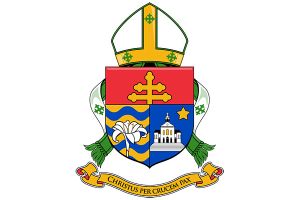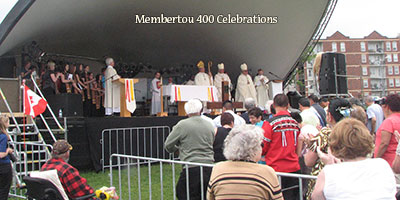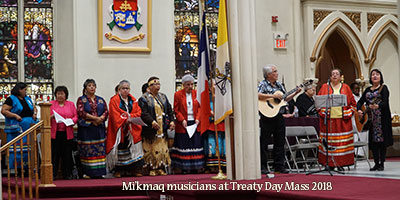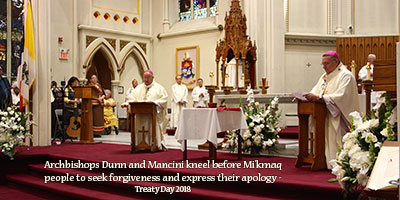
Over the weekend many have heard the news of a mass grave containing the remains of 215 children on the property of the former Kamloops Residential School. Archbishop Dunn adds his prayers to the many individuals, groups, and organizations who are working with our indigenous communities to bring about reconciliation and healing in the midst of hurt and betrayal. He shares the following statement about the tragedy:
Statement from Archbishop Brian Dunn regarding the recent discovery at the
former Kamloops Indian Residential School on the Tk’emlúps te Secwépemc First Nation
On behalf of the Archdiocese of Halifax-Yarmouth, I want to express my deep sadness for the tragic loss of the children at the former Kamloops Indian Residential School on the Tk’emlúps te Secwépemc First Nation. The recent news that the remains of 215 indigenous children were found buried at the former Kamloops Indian Residential School in British Columbia is absolutely heartbreaking. I am conscious that this tragedy has a significant impact on all Indigenous communities, especially those here in Nova Scotia. As Archbishop I want to offer my prayers for these children, their families, and their communities. Acknowledging and bringing to light this dark chapter of our Catholic and Canadian history is difficult but necessary in order to be able to do and be better. I continue to be committed to all who have been mistreated and hurt by the residential school experience, in which Church members participated knowingly or unknowingly. Let us pray for the guidance of the Creator, Son, and Holy Spirit to help us continue working with our indigenous brothers and sisters to take the steps needed towards reconciliation, healing, and peace.
To view Archbishop Dunn’s video message: click here
or visit www.halifaxyarmouth.org/video
The Canadian Conference of Catholic Bishops also released a statement. It can be found in English and French on their website: www.cccb.ca
On Sunday, June 6, Archbishop Dunn offered the Mass for the repose of the souls of the 215 children found in Kamloops. During his homily Archbishop Dunn shared his reflections on residential schools and renewed his commitent to walk with our Mi'kmaq communities to seek a path towards healing and reconcilation. The portion of his homily can be heard by clicking here.
For a PDF version of Frequently Asked Questions:
Residential Schools (June 2021)
please click here or read below
Frequently Asked Questions: Residential Schools (June 2021)
The discovery of children’s remains at the former residential school in Kamloops, British Columbia has reopened a painful wound for many in our country. It has highlighted the need for all Canadians to learn more about our history, the role of residential schools as part of that journey, and to seek the truth regarding all those who suffered and continue to do so to this day.
The abuse of Indigenous peoples is a dark chapter in the history of Canada and the Catholic Church. While the Church has cared for and served Indigenous people in many ways, it is undeniable that some members of the Church undermined the dignity of First Nations people. There is evidence that much of this abuse occurred at residential schools, which were largely operated by Christian denominations.
This following is intended to provide some context and address some frequently asked questions about this important issue. We must all join in the collective efforts on the path to healing and reconciliation with Indigenous peoples.
- I am deeply troubled by the discovery of children’s remains in Kamloops on the site of a former residential school. Who operated the school?
The discovery of 215 unmarked graves in late May 2021 will require further investigation to help seek the truth of who these children were, how they died and how they were buried so far from home. The school was built and initially operated by the federal government, opening in 1890. In 1892, the federal government asked a Catholic order, the Missionary Oblates of Mary Immaculate, to take over operations, which they did until 1969. The federal government resumed operations of the school from 1969 until its closure in 1979.
The religious order issued a formal apology in 1991 in addition to paying settlements to residential school survivors. An excerpt of the apology reads as follows:
“We wish to apologize in a very particular way for the instances of physical and sexual abuse that occurred in those schools…Far from attempting to defend or rationalize these cases of abuse in any way, we wish to state publicly that we acknowledge they were inexcusable, intolerable and a betrayal of trust in one of its most serious forms. We deeply and very specifically, apologize to every victim of such abuse and we seek help in searching for means to bring about healing.”
- Is the Catholic Church assisting with the efforts to seek the truth in Kamloops and elsewhere?
Father Ken Thorson, current Superior of the Missionary Oblates of Mary Immaculate, has reached out to the Tk'emlups te Secwépemc Chief Rosanne Casimir to offer assistance and to express sympathies following the discovery of the remains of 215 children on the grounds of the former school. Father Thorson has communicated that records from the Kamloops Indian Residential School are with the Royal British Columbia Museum and has indicated the order will assist in sharing any information regarding records at this and other locations where the order operated schools.
Among the groups of dioceses and religious communities that operated residential schools, there is a spirit of cooperation with Indigenous peoples with regards to personal records and information relating to the former schools. At the same time, there are also privacy rights, including those of Indigenous peoples who attended these schools, which need to be taken into consideration on a case by case basis.
- Why aren’t we hearing an apology from the Catholic Church in Canada?
There is no such entity as the Catholic Church of Canada. Each Catholic diocese and religious order is an independent legal entity. Despite this reality, in 1991, Canadian Catholic Bishops, along with leaders of men and women religious communities, issued a statement that read “We are sorry and deeply regret the pain, suffering and alienation that so many experienced” at residential schools.
Approximately 16 out of 70 Roman Catholic dioceses in Canada were associated with the former residential schools, in addition to about three dozen out of over 100 Catholic institutes (commonly referred to as religious orders). Each diocese and institute is corporately and legally responsible for its own actions.
Many of the dioceses or orders operating schools have offered apologies, dating back to the early 1990s. In recent days, many bishops throughout Canada have offered statements and introduced other initiatives to continue our ongoing path to truth and reconciliation.
In Nova Scotia, then Archbishop of the Archdiocese of Halifax, Most Reverend Austin Burke visited two Mi’kmaq parish communities within the diocese in 1992 and 1993 to apologize for the mistreatment of Mi’kmaq children at Shubenacadie Residential School. Part of his homily reads:
“I cannot change the past. I cannot erase the damage that has been done. I can express my own sorrow, and the sorrow of your brothers and sisters in our Church of Halifax, for your suffering. I apologize for whatever pain the church itself may have been responsible for causing in the residential school. The church is not meant to hurt, but to heal – and I must say that I am truly sorry if people caused some lingering hurts in the name of the Church.”
Archbishop Burke’s homilies are including in a listing of apologies and other resources can be found on the CCCB website: bit.ly/CCCBreconciliationDocuments
More recently, at the Treaty Day celebration on October 1, 2018, Archbishop Mancini and Bishop Dunn (as Bishop of Antigonish) knelt before the Mi’kmaq chiefs and people gathered and expressed regret, sorrow and apology for the hurts, violence and abuse experienced in the Residential School of Shubenacadie. They also expressed sorrow for the participation of the Church in the promotion of misguided policies of assimilation and for our involvement in undermining aboriginal culture, language and spirituality.
- Who ran the Shubenacadie Residential School and how long did it run?
The school was open from 1930 to 1967 and was the only residential school in the Atlantic Provinces. As part of the residential school system it was run by a variety of church and religious organizations and supported by the federal government. It was first managed by the Archdiocese of Halifax until 1956. It was later administered by the Missionary Oblates of Mary Immaculate who provide a priest as principal for the school. The teachers, cooks, and other staff were religious sisters from the Sisters of Charity of Halifax.
The Sisters of Charity apologized for their role in the residential school at a Truth and Reconciliation hearing in Halifax in 2011.
- Is the site of the former Shubenacadie Residential School being investigated for remains?
On May 31, 2021 the the Kwilmu’ku Maw-klusuaqn Negotiation Office (KMKNO), Mi’kmaq Rights Initiative, released a community notice stating that archeological investigations at the Shubenacadie Residential School are ongoing under the guidance of survivor and respected elder, Dorene Bernard. In April and December of 2020 various locations of the Shubenacadie school site were examined using ground penetrating radar. To date no graves or human remains have been found. The investigations are continuing.
- Have Indigenous leaders met with the Pope?
Yes, in 2009, the National Chief of the Assembly of First Nations, Phil Fontaine, along with other Indigenous representatives, had a moving encounter with Pope Benedict XVI at the Vatican. In describing the meeting, Chief Fontaine told the media he hoped the expression of regret would “close the book” on the issue of apologies for residential school survivors.
Another attendee at the meeting with Pope Benedict, Edward John, Grand Chief of the First Nations Summit in British Columbia, said the Pope acknowledged the suffering of those who are still living with the effects of their experiences at the schools. In comments to the media he said, “I think in that sense, there was that apology that we were certainly looking for.”
The Catholic Church continues to work alongside and with Indigenous communities in order to foster an ongoing culture of reconciliation. There have been, and continue to be, numerous initiatives by Catholic dioceses, institutes and organizations throughout Canada to assist with support the ongoing healing and reconciliation journey.
- I understand there was a formal request in the Truth and Reconciliation Commission report for the Pope to personally apologize in Canada?
The Holy Father has already been invited to Canada by the present and previous Prime Minister. The Catholic Bishops of Canada, including the current and past Presidents of the Canadian Conference of Catholic Bishops, have assured the Pope they would joyfully and gratefully welcome him in a visit to Canada. Likewise, in a number of instances, Canadian Bishops, individually and collectively, have formally invited Pope Francis to visit, including with specific reference to Call to Action #58 (a recommendation of the 2015 Truth & Reconciliation Commission asking the Holy Father to apologize on Canadian soil within one year of the report being issued).
Pope Francis has encouraged the Bishops to continue taking leadership and assuming their proper role in pursuing their pastoral engagement and reconciliation efforts with Indigenous peoples, including ongoing conversations among the Bishops and Elders. This work builds on past apologies, dialogue and the desire to move forward together.
A formal papal visit involves a number of steps from both government and church leadership as well as significant logistical, financial commitments and other considerations. No papal visit has been publicly announced at this time.
- Will the Catholic Church pay financial reparations to those harmed by residential schools?
The Catholic entities that operated residential schools were part of the 2006 Indian Residential School Settlement Agreement (IRSSA).
The Holy See and the Canadian Conference of Catholic Bishops were never involved in running the former schools. The “Roman Catholic Entities” named as parties in the IRSSA were legally deemed to have fulfilled the requirements of the settlement agreement by a judicial review. Following this review, the former Conservative government released the entities from further obligations – a decision which the present Liberal government did not appeal.
The 50 or so individual entities which signed the IRSSA paid:
i. $29 million in cash (less legal costs);
ii. more than the required $25 million of “in-kind” contributions; and
iii. an additional $3.7 million from a “best efforts” campaign.
Those same entities, together with other dioceses, institutes and national Catholic organizations, continue to be involved in efforts across the country to provide in-kind contributions, which go well beyond the scope of the Indian Residential School Settlement Agreement.
- Where can I find additional resources?
Our Lady of Guadalupe Circle is a Catholic coalition of Indigenous people, bishops, lay movements, clergy and institutes of consecrated life, engaged in renewing and fostering relationships between the Catholic Church and Indigenous Peoples in Canada. For more information visit: www.ourladyofguadalupecircle.ca.
The Conference of Canadian Catholic Bishops (CCCBs) also has a section on their website dedicated to Indigenous Peoples that includes current initiatives, a brief history of the CCCBs interactions with Indigenous communities, papal encounters, and other resources. Visit www.cccb.ca/indigenous-peoples/
Find out more about ...

In 1610 after observing and interacting with French missionaries, Grand Chief Membertou decided to become a Christian Catholic. He was baptized by Fr. Jesse Fleche, SJ in February of that year. This essentially meant that the whole Mi’kmaq nation became Catholic. Chief Membertou’s Grand Council advised him to seek a binding accord between the Mi’kmaq nation and the Holy See – a treaty of friendship and peace. This 1610 concordat, agreement between the Vatican and the Mi’kmaq nation, established three things: an equal partnership between the indigenous and the Vatican, acknowledgement of the hospitality extended by the Mi’kmaq to the French missionaries, and an ability for the Mi’kmaq to practice the Catholic faith, including celebrate Mass, in their own language. This last point is of particular note. It was not until the 20th century that other Catholics around the world could celebrate Mass in the local language of the people.
The Mi’kmaq were Influenced by and lived in community with French missionaries and settlers for many years. During those years the Mi’kmaq in Nova Scotia practiced the Catholic faith incorporating Mi’kmaq spirituality in their practice of the faith.
Some key moments in our more recent history:
- 1917 - Sacred Heart Mission Church is established on Millbrook First Nation.
- 1930 – Government opens the Shubenacadie Indian Residential School and is administered by the Archdiocese of Halifax.
- 1948 - St. Catherine Parish is established on Sipekneꞌkatik First Nation (Indianbrook); renamed St. Kateri Tekakwitha Parish in 2012.
- 1956 – Oblates of Mary Immaculate take over administration of the residential school from the Archdiocese.
- 1967 – Shubencadie School closes.
- 1986 – Grand Chief Donald Marshall establishes October 1 as Treaty Day in Nova Scotia.
- 1988 – Saint Mary’s Cathedral Basilica hosts first Treaty Day Mass; this continues to present day.
- 1992 and 1993 – The late Archbishop Austin Burke met with the Mi’kmaq people in Sipekneꞌkatik First Nation and Millbrook First Nation to celebrate a Mass with them and apologize for the Church’s part in Shubenacadie Indian Residential School.
- 2011 - Representatives from the Archdiocese, including Archbishop Emeritus Mancini, take part in the Truth and Reconciliation Hearings in Halifax.
- 2018 – Archbishop Emeritus Mancini and Bishop Dunn, then bishop of the Diocese of Antigonish, meet with Mi’kmaq representatives in a series of Listening Circles with the aim of listening to hear the experience of the Mi’kmaq and what is wanted and needed as pastoral support to the community.
- 2018 – At the October 1 Treaty Day Mass, Archbishop Mancini and Bishop Dunn (then bishop of the Diocese of Antigonish) kneel before the Mi’kmaq chief and people present to express their sorrow and apology for the wrongs done by the Church at Shubenacadie Indian Residential School and ask for their forgiveness.
- 2021 – Archbishop Dunn offers a Sunday Mass for the repose of the souls of the 215 children found on the former grounds of Kamloops Indian Residential School. During his homily he shares his reflections on residential schools and offers his apology and support to the Mi'kmaq.

The residential school system is a dark mark in the history of Canada and the Church. It is important to listen to the experiences of residential school survivors. As Catholics, and Canadians, we must acknowledge the hurt and trauma caused, apologize for the wrong doing, and take the necessary steps to work together – indigenous and non-indeginous - to find a path that leads to healing and reconciliation.
Shubenacadie Residential School
Open from 1930 to 1967, Shubenacadie Residential School was the only residential school in the Maritimes. It functioned within the residential school system put in place by the government and administered by churches and religious organizations. The aim of the school was to assimilate Indigenous children as part of a nationwide effort to suppress Indigenous culture, identity, and history. When it opened the school was administered first by the Roman Catholic Archdiocese of Halifax and later the Missionary Oblates of Marie Immaculate and staffed by the Sisters of Charity of Halifax.
Mi’kmaw and Wolastoqkew children from Nova Scotia, Prince Edward Island, New Brunswick, and Quebec attended Shubenacadie Indian Residential School. There are many horrific stories of students experiences that included harsh discipline; malnutrition and starvation; poor healthcare; physical, emotional, and sexual abuse; medical experimentation; neglect; the deliberate suppression of their cultures and languages; and loss of life. While touted as a place of education we now know it was far from that.
The Shubenacadie Indian Residential School was built in 1928-29 in the Sipekni’katik district of Mi’kma’ki, at the top of a small hill between Highway 2 and the Shubenacadie River overlooking the village of Shubenacadie. It is seven kilometers from Sipekne’katik First Nation. The abandoned school building was demolished in 1986 after a fire burnt most of the building. A plastics factory now stands where the school used to be.
In 2020 the site was designated a National Historic Site by Parks Canada. There are plans for a commemorative plaque to be placed at the site in the fall of 2021.
Residential Schools FAQs
The discovery of 215 unmarked graves of children found on the grounds of the former Kamloops Indian Residential School in May 2021 shone the light once again on the residential school system. At that time a list of Frequently Asked Questions was created and can be found by clicking here.

Treaty Day was established on October 1, 1986 by Grand Chief Donald Marshall Sr. This day commemorates the key role of treaties between the Nova Scotia Mi’kmaq and the Crown. The day specifically recalls the Treaty of 1752. The annual ceremony reaffirms the historic presence of the Mi’kmaq who have occupied the land for thousands of years who sought to find friendship and peace with the early settlers. The Mi’kmaq Nation and the Crown exchange gifts to mark each October 1.
Treaty Day activities and events are a way for Mi’kmaq to gather and for non-indigenous people to learn more about Nova Scotia’s history. Each year Saint Mary’s Cathedral Basilica hosts a Treaty Day Mass as part of the festivities. At this celebration representatives of the Church, Mi’kmaq chiefs and people, and many others, come together in worship and prayer.
All are welcome to join in the Treaty Day Mass annually held on October 1 at 9:30am.

Throughout the life of the local Church in Nova Scotia, church leadership have prayed with, had conversations with, and offered pastoral support to the Mi’kmaq communities. In the early years of Nova Scotia’s beginnings, there are accounts of interactions with French missionaries, early Acadian settlers, Jesuits missionaries as well as others where faith was shared. In more recent times, some notable encounters include:
- In 1992 and 1993 the late Archbishop Austin Burke met with the Mi’kmaq people in Sipekneꞌkatik First Nation and Millbrook First Nation to celebrate a Mass with them and apologize for the Church’s part in Shubenacadie Indian Residential School.
Copies of his homilies can be found by clicking here.
- In 2010 a number of Bishops and other clergy took part in celebrations as part of a great powwow held to commemorate the 400th Anniversary of Grand Chief Henri Membertou’s baptism into the Catholic faith. This four - day gathering took place on the Halifax Commons.
- In 2011, Archbishop Mancini and other representatives from the Archdiocese of Halifax-Yarmouth took part in the Truth and Reconciliation Hearings in Halifax.
- In the spring of 2018, Archbishop Emeritus Mancini and Bishop Dunn, then bishop of the Diocese of Antigonish, met with Mi’kmaq representatives in a series of Listening Circles with the aim to listen to one another and find ways to work together to better the relationship between the Mi’kmaq and the local Church.
- In 2018, at the Treaty Day Mass on October 1, Archbishop Mancini and Bishop Dunn (then bishop of the Diocese of Antigonish) knelt before the Mi’kmaq chief and people present to ask for their forgiveness and express their sorrow and apology for the wrongs done by the Church at Shubenacadie Indian Residential School.
- In June of 2021 Archbishop Dunn offered a Sunday Mass for the repose of the souls of the 215 children found on the former grounds of Kamloops Indian Residential School. During his homily he shared his reflections on residential schools and offered his apology and support to the Mi'kmaq. The Archbishop spoke of what our Church has done in the recent past as well as what he hopes we can continue to do moving forward. The portion of Archbishop Dunn’s homily where he speaks of the residential schools can be watched here: www.youtube.com/watch?v=D_JZ_YDZXKghe or visit Video: halifaxyarmouth.org/video

Historical accounts from Catholic clergy and missionaries in the 18th century speak to the efforts representatives of the Church made to learn about the Mi’kmaq people and culture. Many missionaries also learned the Mi’kmaq language so that faith teaching and prayer could be better said and understood.
Finding a common language or common ground can be achieved by learning to listen better to one another - truly listen. Archbishop Dunn hopes to do just that – listen and learn from the Mi’kmaq. He has expressed his commitment to working with our local Mi’kmaq communities to seek a path that will lead us all towards a stronger relationship between the local Church and our indigenous communities.
Plans for more Listening Circles, educational opportunities for clergy and the faithful, and shared moments of prayer and worship such as Treaty Day are some of the small ways that the Archdiocese of Halifax-Yarmouth is creating spaces for sharing, storytelling, and faith. May we find more opportunities to better know and learn the stories and culture of our Mi’kmaq brothers and sisters.
Saint Kateri Tekakwitha and Saint Anne, pray for us!
Recent Letters to the Mi’kmaq
- Archbishop Dunn's Letter to Indigenous Leaders - June 2023
- CCCB pastoral letters to Indigenous People of Canada
Mi’kmaq Parishes in the Archdiocese of Halifax-Yarmouth
FAQ's
Residential Schools
Frequently Asked Questions
(June 2021)
Contact
(902) 429-9800
Resources:
- Reconciliation Fund Collection FAQs - from Archdiocese of Halifax-Yarmouth
- Residential Schools - FAQ's - from Archdiocese of Halifax-Yarmouth
- CCCB Indigenous Peoples Page – prayers, initiatives, and resources from the Canadian Conference of Catholic Bishops.
- Truth and Reconciliation Commission Reports
- Our Lady of Guadalupe Circle – a Catholic coalition of Indigenous people, bishops, clergy, laity and religious engaged in renewing and fostering relationships between the Catholic Church and Indigenous Peoples in Canada.
- Kwilmu’kw Maw-klusuaqn -Mi’kmaq Rights – an advocacy group that works to uphold Treaty rights.
- Residential Schools - FAQ's - from Archdiocese of Toronto: English (pdf) - French (pdf)
